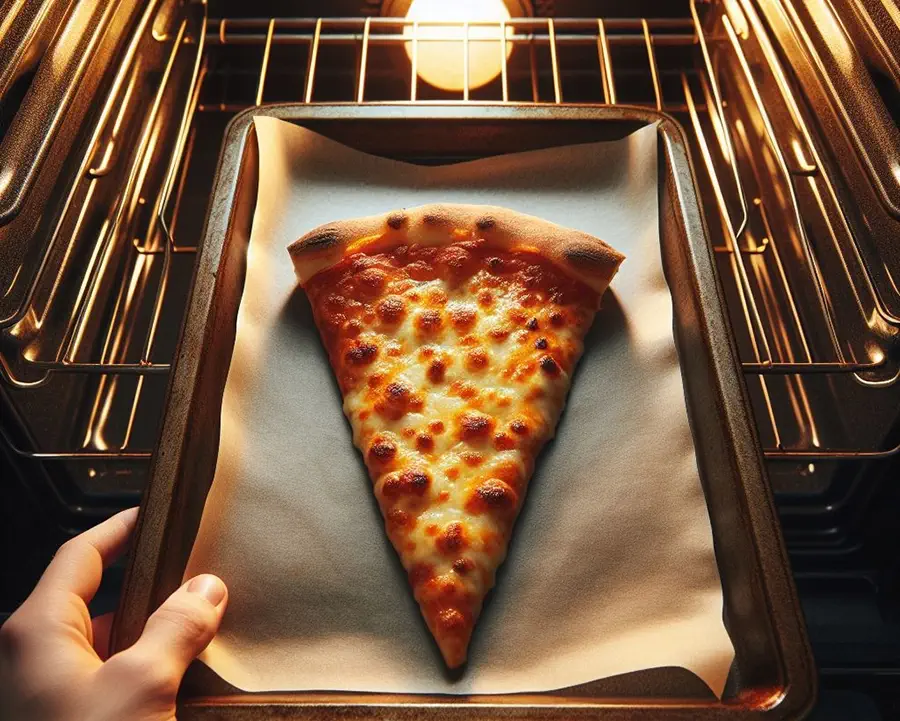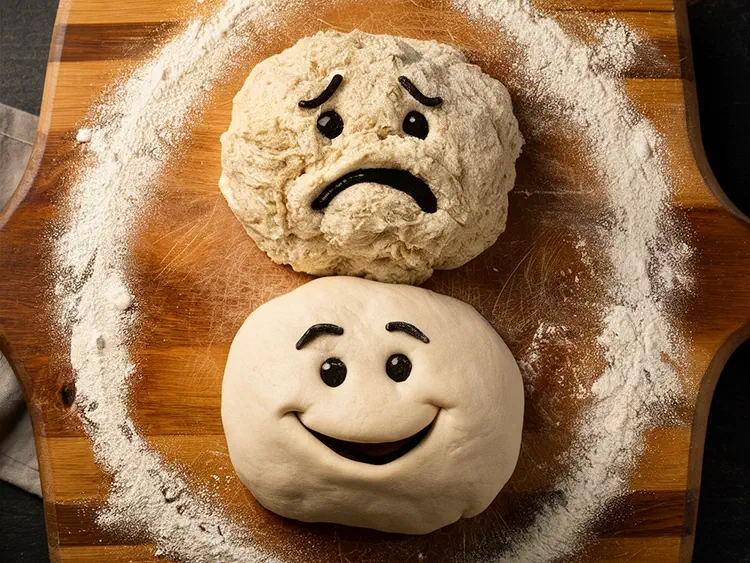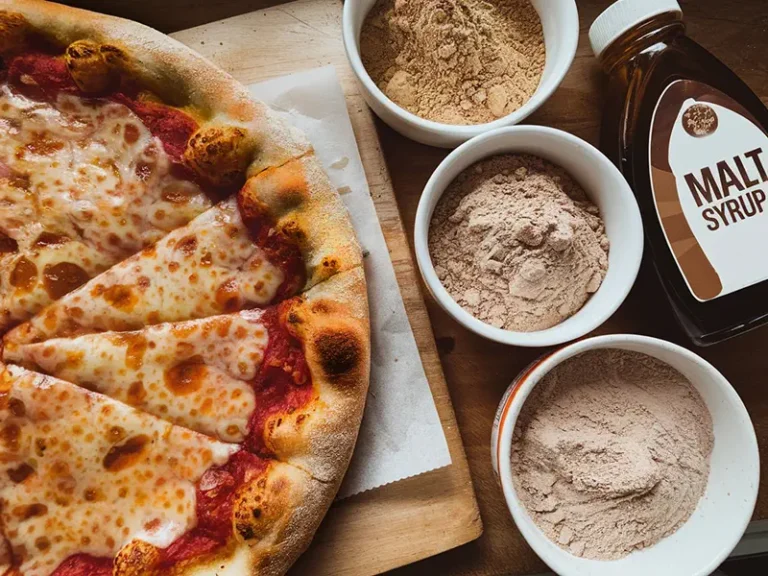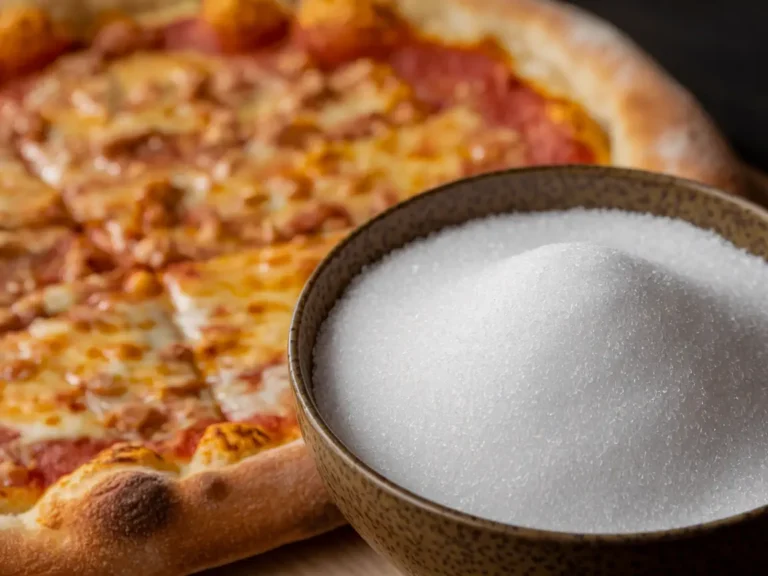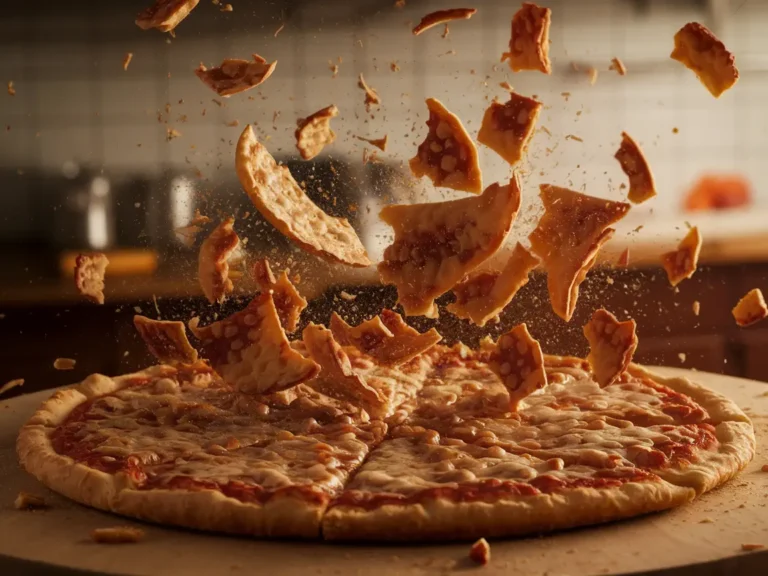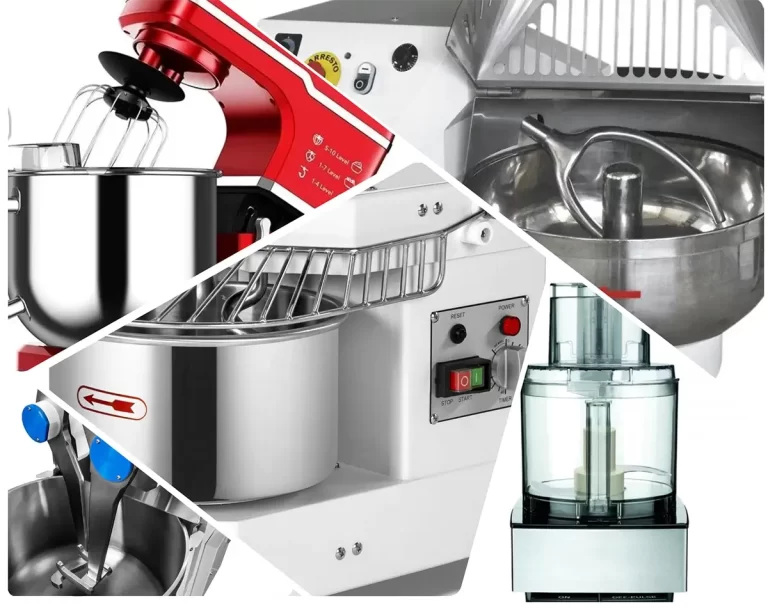How to Reheat Pizza: Best Way to Reheat Explained [A Practical Guide to Perfect Leftovers]
There are several ways to reheat pizza, but which method is best? In this article, we’ll explore the most popular ways to reheat pizza, discuss the pros and cons of each, and guide you on how to bring your leftover pizza back to its crispy, cheesy best
Reheating Pizza: Introduction
When pizza cools or is stored, whether briefly or for an extended period, it inevitably loses some of its original qualities:
- The crumb becomes tough and leathery, losing its softness.
- The crust loses its crispiness, turning spongy or mushy.
For more on how baked goods go stale and lose their freshness, see Why Pizza Becomes Tough When It Cools and How to Preserve Its Freshness [What Makes Baked Goods Go Stale].
Proper reheating of leftover pizza aims to reverse these changes, and restore it as closely as possible to its freshly baked state.
There are several ways to reheat or rewarm pizza, some more effective than others. Below, we’ll cover the most popular ones.
Ideally, reheating should:
- Restore softness: The crumb becomes soft and tender again.
- Restore crispiness: The crust regains its crisp texture (if desired).
- Ensure uniform heating: The entire pizza, including the dough, sauce, cheese, and toppings, is evenly warmed – avoiding cold spots or overheated areas.
In summary: The goal in reheating is to recreate the experience of a freshly baked pizza – soft on the inside, crispy on the outside, and evenly heated – so it can be enjoyed to the fullest, just like when it first came out of the oven.
Pizza Reheating Methods
In the following sections, we’ll cover the most common methods for reheating pizza, including:
- Microwave
- Toaster
- Pan (covered and uncovered)
- Oven(s)
- Air fryer
We’ll explore the advantages and disadvantages of each method and explain how to restore your pizza to its maximum freshness.
For a deeper understanding of how pizza is baked and how different heating methods impact reheating, I highly recommend reading How Pizza is Baked: Understanding the Thermodynamics of Pizza Baking.
Reheating Pizza in the Microwave
The microwave is one of the easiest and most convenient ways to reheat pizza, effectively restoring its softness.
However, proper use is crucial. Overheating using the microwave can make the pizza excessively soft, spongy, or mushy, and once it cools, it can quickly turn tough.
Microwaves heat food by penetrating it and causing water molecules to ‘vibrate,’ generating heat. This method has several major drawbacks when it comes to reheating pizza:
- Uneven heating: Microwave waves heat water molecules inconsistently, leading to hot and cold spots. This is why microwaved food often has areas that are very hot, while others remain lukewarm or cold.
- Intense and rapid heating: The microwave’s high intensity accelerates moisture evaporation, especially in hotter areas. Some parts of the pizza may dry out, while others stay overly moist. Excessive localized heat can also cause starch and gluten to overheat, resulting in a leathery texture.
- Quick toughening when cooled: Because of the uneven heating and moisture loss, microwaved pizza toughens and becomes leathery more quickly than with other reheating methods.
- Cannot restore crispiness: The microwave does not allow the crust to regain any crispiness, leaving the dough completely soft.
For these reasons, the microwave is not the best option for reheating pizza. If not carefully monitored, it can result in a pizza that:
- Becomes spongy and loses its structure, then quickly turns tough and leathery once it cools.
- Heats unevenly – some parts may be steaming hot, while others remain cold. For example, the toppings or dough may overheat, while the sauce or cheese are still cold.
That said, if you’re short on time, have no other options, or simply don’t feel like using another method, the microwave is a reasonable fallback – just don’t expect the best results.
Microwave heating is far more effective for baked goods that are meant to be very soft with no crispiness, such as pita bread, soft buns and rolls, and even Neapolitan pizza.
Guidelines for Effectively Using the Microwave to Reheat Pizza
To achieve the best results when reheating pizza in the microwave, follow these guidelines:
- Use medium-low power (40-60%): Lower power settings allow for more even reheating.
- Heat in short pulses: Microwave in short pulses of 10-20 seconds, checking frequently. Even a few extra seconds can mean the difference between perfectly reheated pizza and an overheated one.
- Use the microwave as a preheater [see next section]: a brief preheating in the microwave can be used to partially warm and soften the pizza before finishing the reheating with another method.
In standard microwaves (not inverter-type), lower power settings (typically ranging from 10-100% in 10% or 20% increments) do not actually reduce the microwave’s energy output. Instead, the microwave cycles on and off intermittently.
For example, at 100% power, it runs continuously, while at 60%, it operates at full power for 60% of the time, and remains off for the other 40%. In contrast, inverter-type microwaves adjust their actual power output, providing a steadier, lower-intensity heat.
Using the Microwave to “Preheat”
Microwave heating is most effective as a “preheater” when combined with other reheating methods.
A brief microwave session of up to 30 seconds, depending on your microwave and pizza being warmed, helps partially heat and soften it before transferring it to another heating device for final reheating.
After preheating in the microwave, completing the process with a different method provides three key benefits:
- Shorter overall reheating time.
- More even reheating, preventing inconsistencies in softness and eliminating hot or cold spots.
- Restored crispiness, if desired, by using a method better suited for restoring crispiness.
Reheating Pizza in a Toaster (Sandwich/Press/Panini Toaster)
A press or panini toaster can effectively reheat individual slices of pizza, especially thin ones, but it must be used correctly.
A press toaster heats food using two plates – an upper and a lower – that transfer heat through conduction (direct contact) and/or radiation (similar to an oven’s heating elements).
The main challenge with a press toaster is its design – it “presses” and flattens whatever is inside. To reheat pizza properly, the upper plate must be elevated, so it does not touch the pizza (for obvious reasons). This can be done by placing a heat-resistant utensil, such as a wooden or metal spoon, between the upper and lower plates – anything that prevents direct contact will work.
It’s also crucial to position the top plate close to the pizza, ideally just a few centimeters or inches above it. If it’s too far away, it won’t radiate enough heat, resulting in an overheated or burnt base, while the top (sauce, cheese, and toppings) stays cold or underheated.
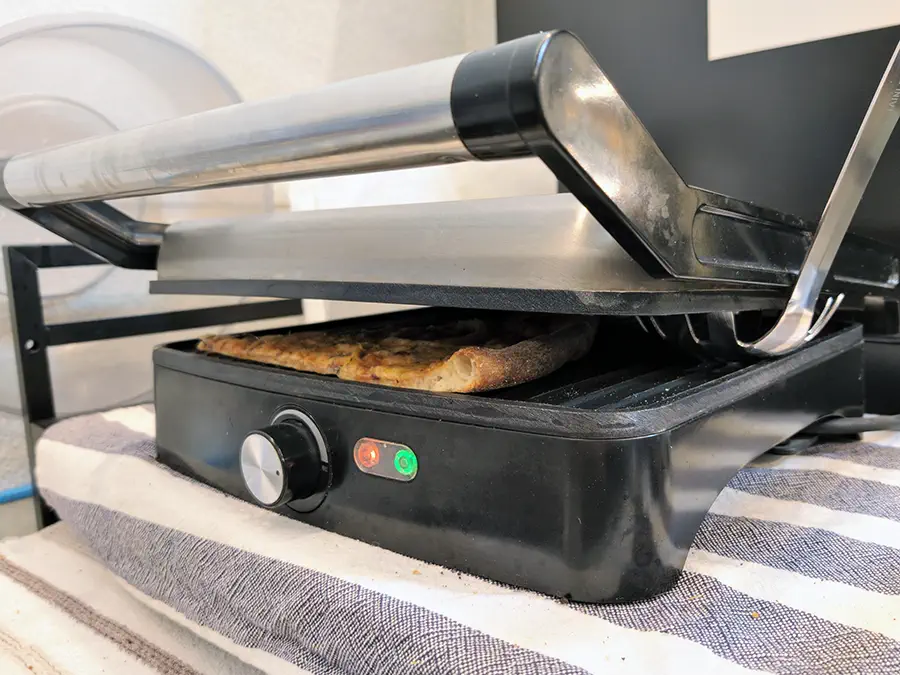
The toaster’s type and power also impact heating efficiency. If it lacks sufficient power, reheating may take too long, leading to uneven heating results.
When used correctly, a press toaster can effectively restore both the pizza’s internal softness and external crispiness. For best results, preheating in the microwave before using the toaster significantly reduces heating time and ensures more even warming.
In summary: A press toaster can be a great option for reheating pizza, but following these key guidelines is essential for best results.
Reheating Pizza in a Pan on the Stovetop (Without a Lid)
Reheating pizza in a pan is similar to using a press toaster, with one key difference: there is no heat from above. Instead, only the bottom of the pizza is heated through direct contact (conduction).
Because this method lacks upper heat, it is not ideal for thoroughly reheating pizza. While it can effectively warm the base and restore its crispiness, the absence of top heat leads to uneven heating, particularly in the sauce, cheese, and toppings.
Additionally, this method cannot restore crispiness to the crust in the rim (cornicione).
In summary: unless you’re only looking to warm the bottom of the pizza, it’s best to use other methods.
Reheating Pizza in a Pan on the Stovetop (With a Lid)
Using a lid traps moisture released from the sauce, cheese, dough, and toppings during reheating. This creates a humid environment where steam circulates and transfers heat effectively, warming the top of the pizza as well.
However, this method has several drawbacks:
- The heat generated from water evaporation may not be sufficient to heat the top of the pizza well or evenly.
- The steam inside the pan prevents the rim (cornicione) from becoming crispy, making it unsuitable for pizzas where crispiness is desired.
That said, this method is ideal for reheating Neapolitan pizza, where softness is the priority. The added humidity helps restore the pizza’s tenderness, making it a great choice for this style.
If using this heating method, it’s important to monitor the flame – too much heat can burn the bottom of the pizza. A medium flame and frequent checking are recommended.
For additional moisture and more effective heating, you can drizzle a little water or add an ice cube to the pan. However, be cautious – too much moisture can make the dough soggy. If excess water accumulates, briefly remove the lid to let it evaporate.
In summary: This method works well for Neapolitan pizza, or situations where crispiness is not a priority. For other styles, it’s less ideal.
Reheating Pizza in a Live-Fire Oven
Reheating pizza in a live-fire oven, whether wood or gas-fired, is generally not recommended, especially for frozen pizza.
Live-fire ovens rely on direct heat from an open flame, which creates highly uneven reheating. The intense, localized heat affects only the portion of the pizza closest to the flame, requiring frequent rotation to avoid burning.
For frozen pizza, this method is even less suitable. The intense heat can cause the outer sections to overcook, while the inner dough remains cold or even frozen.
Once a pizza is fully baked, the high temperatures of a live-fire oven provide no advantage for reheating. Unlike the initial baking process, where extreme heat plays a key role, reheating does not benefit from high temperatures.
A brick live-fire oven, which absorbs and stores heat, can reheat pizza more evenly using the stored heat (without a live fire), but even then, the benefits are minimal. The stored heat radiates in a more uniform manner compared to the intense, focused heat of a live flame. However, even in this scenario, the only advantage is utilizing the residual heat in the oven walls, offering no significant benefit over other reheating methods.
In summary: Reheating pizza in a live-fire oven requires extra effort with little reward. Other reheating methods are far more effective.
Reheating Pizza in the Oven (Including Toaster Oven)
A toaster oven is essentially a small oven, so the following information also applies to toaster ovens.
In most cases, an oven is the best choice for reheating pizza, offering several key advantages:
- Even and uniform heating across the entire pizza.
- Precise temperature control for consistent results.
- The ability to restore crispiness to the pizza.
- Adjustable oven functions to tailor the heating process.
- The capacity to heat multiple slices or even an entire pizza at once.
How to Effectively Reheat Pizza in an Oven
Preheat the oven to 180°C/350°F, using the conventional baking mode (top and bottom heat, no convection/fan). This temperature will help the crumb regain its softness, without overly drying out the crust.
Once the oven is preheated, which should take around 15 minutes, place the pizza on the middle rack, and heat for 5-10 minutes, depending on the thickness and condition of the pizza (whether it’s frozen or preheated in the microwave).
Frozen pizza can be reheated directly from the freezer, but this will extend the reheating time. For the best results, use the microwave to preheat the pizza first, then transfer it to the oven to finish heating (and crisping).
What Surface to Use to Reheat Pizza in the Oven
The surface you use to reheat pizza in the oven primarily impacts the heating of the pizza’s bottom, which in turn affects its crispiness.
You have several options for placing the pizza in the oven:
Baking Surface (Stone / Steel / Cast Iron): Heating the pizza on a baking surface maximizes the crispiness of the bottom. However, this requires preheating the surface along with the oven for at least 15 minutes, which may not be practical for reheating individual slices.
Baking Sheet / Pizza Pan: This convenient option works well, although it doesn’t fully maximize the crispiness of the bottom. If using a baking sheet, you can place it upside down to make it easier to place and remove the pizza, especially for heating whole pizzas. You can place parchment paper or tin foil under the pizza.
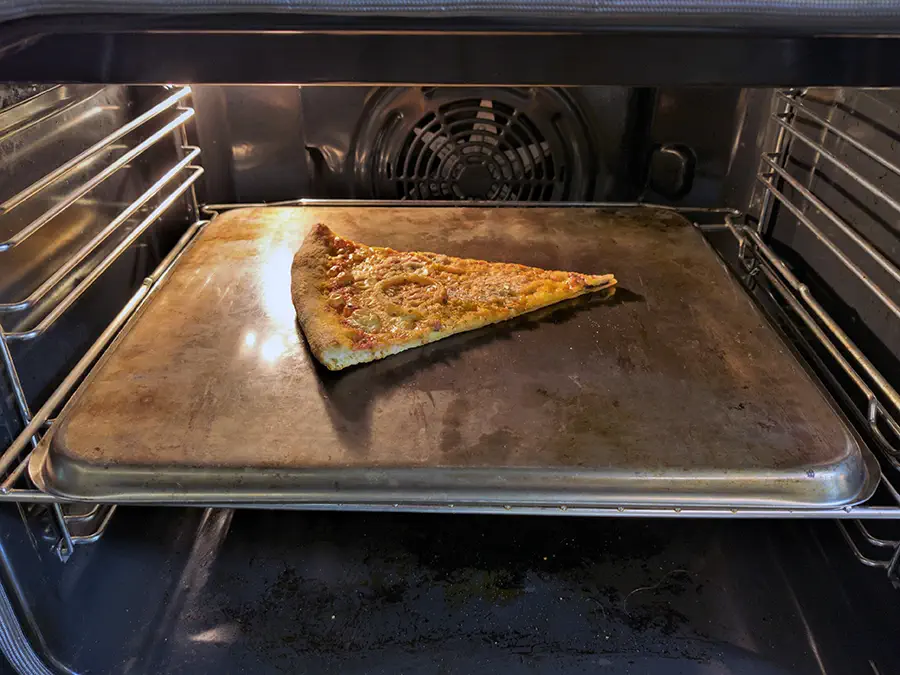
Directly on the Oven Rack/Grid: This method works exceptionally well because it allows the oven heat to reach the bottom of the pizza directly, restoring crispiness effectively – especially if you use the convection mode (discussed in the next section). However, it can be tricky, as cheese or toppings may fall through the gaps in the rack, creating a mess at the bottom of the oven.
You can use parchment paper or tin foil to place the pizza directly on the oven rack. However, keep in mind that this will block some of the heat from reaching the bottom, preventing maximum crispiness.

Using Convection Mode [Fan Forced] to Restore Crispiness
Convection mode, aka ‘fan-forced’, circulates hot air in the oven (through forced convection), resulting in uniform heat distribution. One major side effect of using convection mode is the drying of the food being heated, making it particularly effective for restoring crispiness to the crust.
For detailed information on convection mode, how it works and how to use it, see How to Bake Pizza in a Home Oven: Everything You Need to Know [A Practical Guide].
With that said, when using convection mode to reheat pizza, it is recommended that the pizza is at room temperature or preheated in the microwave.
Reheating frozen pizza in convection mode may result in uneven heating, causing the exterior to dry out before the inside is properly heated (for example, the cheese may dry out while the sauce and dough underneath haven’t heated sufficiently).
A great technique for restoring crispiness is to turn on convection mode during the last minute or two of reheating, once the pizza is mostly warmed. This ensures the crust gets a boost of crispiness, without risking over-drying or uneven heating.
When using convection mode, whether for the entire reheating process or just to finish crisping, it’s important to monitor the pizza closely to prevent excessive drying.
Reheating Pizza in an Air Fryer
An air fryer works on the same principle as an oven’s convection mode – circulating hot air (forced convection). Therefore, everything mentioned in the previous section about using convection mode also applies when using an air fryer for reheating.
How to Reheat Pizza in the Oven: A Step-by-Step Guide
The guidelines below apply to fully baked pizza, meaning it was completely cooked and then stored as leftovers. This differs from a par-baked pizza, where the dough is baked until set (but not browned), after which sauce, cheese, and toppings are added before the pizza is frozen with “raw” ingredients. This category includes frozen pizzas sold in supermarkets, or pizzas intended for freezing right after baking.
If you want to reheat a partially baked pizza, the instructions remain the same, except for the heating temperature – heat at 250°C (480°F).
Below are step-by-step instructions for reheating a whole pizza or individual slices in the oven:
1. Microwave preheating (optional, but recommended for reheating frozen individual slices): Heat the slices in the microwave for no more than 30 seconds, until the dough and cheese feel slightly warm and are no longer frozen.
2. Preheat the oven: Preheat the oven to 180°C (350°F) using conventional baking mode (top and bottom heating elements, no convection). Position the pizza on the middle rack. For optimal results, allow the oven to preheat for at least fifteen minutes before placing the pizza inside. If using a baking surface to reheat, preheat it along with the oven.
3. Place the pizza in the oven: Place the pizza on the baking surface or directly on the oven rack.
4. Allow to reheat: Heat the pizza for 5-10 minutes, or until the cheese begins to bubble or feels warm to the touch. Check the pizza every minute or two, touching different areas to ensure the entire pizza is evenly heated – there’s nothing more frustrating than taking a bite and discovering cold spots.
5. Using convection mode (optional): For added crispiness, turn on convection mode for a minute or two at the end of the heating process.
6. Cooling and serving: Remove the pizza from the oven and place it on a raised surface to allow steam to escape for at least a minute. This step is crucial to prevent the bottom from absorbing moisture and becoming soggy. Once the steam has stopped, transfer the pizza to a plate or serving dish, and enjoy!
Enjoy the content on PizzaBlab? Help me keep the oven running!

